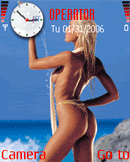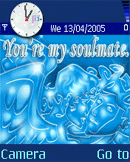
Nokia have announced the Nokia N95, featuring an innovative double slide design with multimedia controls and a keypad on opposite end of the phones. Read on for full details, pictures and the full press release. Summary: The N95 is Nokia’s first HSDPA (3.5G) device, but also boasts Wi-Fi, WCDMA, quad-band GSM, Bluetooth (including A2DP), IrDA and USB 2.0 connectivity (via mini USB connector).

Other hardware features include a 5 megapixel camera, a built in GPS, TV-Out, 3.5mm audio jack, FM Radio, a MicroSD memory card slot and 150MB of internal memory. In the hand the most impressive aspect of the device, given its feature set, is its size. At 99mm x 20mm x 53mm (90cc), the N93 packs an impressively amount into a small space. Nokia have managed to add two major technologies to the Nseries line (GPS and HSDPA) while significantly reducing the volume of the device. In length and width dimensions it is larger that the other Nseries slider - the N80, but it is considerably thinner.

HSPDA is the next generationin cellular connectivity. The N95 is a category 6 HSPDA device which means it is up to 10 times faster that WCDMA (3G). Clearly HSDPA support is required at a network level, but many networks have already begun their testing or roll out periods.

The faster connection speeds make downloading media (such as podcasts via the in built Podcast application) more palatable and should also improve latency/round trip times. Wi-Fi, WCDMA (3G) connectivity, together with quad band GSM and EDGE are also supported. Bluetooth 2.0, IrDA and USB make up the local connectivity options. The 5.0 megapixel camera uses Carl Zeiss Optics with autofocus and digital zoom with a dedicated 2 stage capture button on the side of the phone. Video capture at near DVD quality is also supported. On the side of the device there are several buttons dedicated to camera usage.

This allows the device to be held in a similar way to a traditional camera with the screen, in landscape mode, used as the view finder and the shutter button on bottom right hand side of the device (top right when phone is held horizontally). On the rear of the device, next to the camera is the slide switch, which is used to open the lens aperture and activate camera mode. Although it is difficult to judge the image quality at this stage the evidence we saw suggest that the N95 will be on of the most capable camera phones available.

A GPS is integrated into the device with anticipated accuracy of around 10m (satellite signal permitting). The devices will ship with an application called Maps which has global overview maps built in. More detailed maps (with coverage over more than 100 different countries available) can be downloaded for free from an online server. The detail available varies from country to country, but in many cases it is available down to street level. A point of interest (POI) database is also included.

All the maps are available for free, as is basic route planning, but navigation functionality (with voice and on screen prompts) will be available as a pay-for add on. City Guides will also be available for purchase and other services are likely to be made available in the future. The mapping software and services is likely to based on technology from gate5, a company which Nokia recently announced it was acquiring.

Music playback is also a major focus of the device. The dedicated multimedia keys on the top flip of the device are primarily designed for music playback (although can also be used in other multimedia contexts). Wireless stereo sound output (via the A2DP Bluetooth profile) is also supported,

and stereo audio output is also supported by the TV output feature and the on board stereo speakers. The music formats supported include MP3, AAC, AAC+ and WMA. Video playback on the QVGA screen is excellent and supported video formats include 3GP, Real Video and MP4 with support for the latest AVC codec.

The multimedia key now leads to a revamped application and multimedia shorcut view which now supports both a greater number of shortcuts (applications, multimedia files and bookmarks) and more flexible personalisation. As a result it is now a more generic shortcut key mechansim and offers an alternative to the standard application launcher. The N95 uses S60 3rd Edition Feature Pack 1 (Symbian 9.2) and as such includes version 2.0 of the open source Nokia web browser (supporting WML, XHTML and HTML in one browser), Flash Lite 2.0, FOTA (firmware over the air updates) and more.

The N95 uses the same small power port as other S60 3rd Edition devices, but the in-box charger is considerably smaller than the existing models (up to 60% smaller). The N95 has a 950 mAh battery, it is likely that the N95 will require a daily charge with moderate to heavy use, although 3-6 days may be possible with lighter use (dependent on network strength, type and other factors). The N95 will be available in Q1 2007 and the approximate unsubsidised price is €550. Initially it will be available in the EMEA market. It will not be officially available in the US although gray imports are very likely.


No comments:
Post a Comment